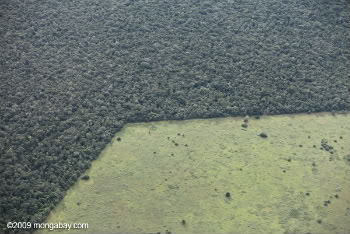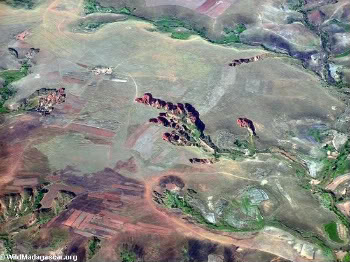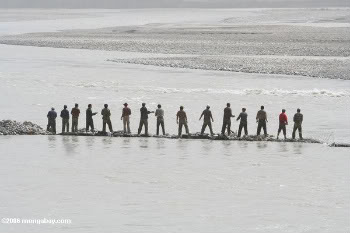|
|
Researchers interview villagers in Yorkshire to prove the unreliability of people’s perception of nature
The theory of shifting baselines was first elucidated by scientists exploring urban children’s perception of nature in 1995. In the same year, marine biologist Daniel Pauly coined the term ‘shifting baselines’. Since then the idea of humans perceiving nature inaccurately, through ‘shifting baselines’, has taken the conservation world by storm: the theory appeared to describe a commonly noticed problem regarding people’s view of the natural world around them. However, the theory had yet to be tested in a scientific manner: were people actually undergoing shifting baselines or was something else going on? For the first time a new paper in Conservation Letters empirically tests the shifting baselines theory.
“The shifting baseline syndrome is the situation in which over time knowledge is lost about the state of the natural world, because people don’t perceive changes that are actually taking place. In this way, people’s perceptions of change are out of kilter with the actual changes taking place in the environment,” Dr. E.J. Milner-Gulland, one of the paper’s authors, told mongabay.com.
 Deforestation in Brazil. Photo by: Rhett Butler. |
In other words, due to short life-spans and faulty memories, humans have a poor conception of how much of the natural world has been degraded by our actions, because our ‘baseline’ shifts with every generation, and sometimes even in an individual. In essence, what we see as pristine nature would be seen by our ancestors as hopelessly degraded, and what we see as degraded our children will view as ‘natural’.
However, as the paper’s authors write, “one of the biggest current issues in assessing the implications of [shifting baselines syndrome] is the lack of empirical evidence that it occurs.”
Generational and personal amnesia
In their study professor of Conservation Science at Imperial College London, Milner-Gulland, and colleagues tested two different types of shifting baselines: generational amnesia and personal amnesia. The use of the word ‘amnesia’ is important because any experience of shifting baselines involves a loss of information without being aware of the loss, a kind of amnesia.
 Erosion in western Madagascar. Photo by: Rhett Butler. |
“Generational amnesia is when knowledge is not passed down from generation to generation. For example, people may think of as ‘pristine’ wilderness the wild places that they experienced during their childhood, but with every generation this baseline becomes more and more degraded,” Milner-Gulland explains.
For example, if legendary conservationist John Muir returned to Northern California today there is no doubt that he would believe much of the wilderness he loved to be terribly, hopelessly altered: dams, roads, suburbs, etc. However, a native Californian may see parts of their landscape as perfectly natural: National Parks are often view by Americans as the emblem of nature—even with roads running through them clogged with traffic. This type of altered perception of nature occurs with each succeeding generation.
Rather than occurring at every generation, personal amnesia happens quicker, during a single individual’s lifetime. “Personal amnesia is when people forget how things used to be during the course of their own lives, for example they may not remember that things which are rarely sighted now were once common,” says Milner-Gulland. In this case, the individual actually ‘updates’ the change involved, so that the change (and the past) is forgotten and the new state becomes the baseline.
Shifting baselines of birds in Yorkshire
 Diverting river in China. Photo by: Rhett Butler. |
Shifting baselines requires that an ecosystem has changed. Looking at changing bird populations in Yorkshire County in England, the researchers were able to show empirical evidence of a population undergoing ‘shifting baselines’, both through generational amnesia and personal amnesia.
Having concrete data of bird population shifts in Yorkshire, the researchers interviewed 50 rural villagers regarding their perception sof changes in birdlife surrounding them. Interviewees were asked what the most common birds in Yorkshire were today and 20 years ago. Researchers received a wide variety of answers.
They found evidence of “generational amnesia in that older people were more accurate at naming the commonest birds 20 years ago than younger people were,” Milner-Gulland says. “This is not because older people are just better at naming common birds, because there was no difference in accuracy for the present-day birds. So it suggests that there is a difference between generations in understanding of how the typical bird fauna of the village has changed over time.”
In addition researchers found that over one-third of participants had a static view of bird species in Yorkshire. In other words, they chose the same species as common twenty years ago as currently.
 Cleared mangrove forest for aquaculture in Indonesia. Photo by: Rhett Butler. |
“The evidence for personal amnesia comes from an analysis of the responses of those people who thought that the bird fauna of the area had not changed,” Milner-Gulland explains. “These people tended to think that the bird fauna has always been how it is now, rather than naming those birds which were more common in the past. This suggests that they were updating their perceptions over time without realizing it.”
Researchers could find no underlying reason why certain people had a static view of bird populations while others saw change—accurately or inaccurately.
The authors conclude that “this study provides the best evidence to date for generational and personal amnesia.”
Implications for conservation
“If we don’t realize what we are losing we stand the risk of sleepwalking through the destruction of the natural world without taking action to remedy the situation,” Milner-Gulland says, explaining the importance of the shifting baselines theory to conservation.
 Shipment of coal in China. Photo by: Rhett Butler. |
When people’s views of pristine nature shift with every generation, or even in an individual life, it makes conservation work difficult. How can environmentalists convince people that the environment is degraded if they don’t see it that way? This is the fundamental difficulty behind shifting baselines syndrome: how to make conservation important when people do not see the loss.
For example, in the western United States wolves have been locally extinct for so long that no one remembers when they were plentiful. As far the community is concerned wolves are not a part of the natural environment, therefore this personal perception of nature could add to their resistance to wolf reintroductions in the region.
The problem is especially exacerbated when scientific data is not available regarding past conditions of an ecosystem, unlike wolf populations in the United States. Unfortunately hard data is often difficult to come by, especially for environmental conditions generations ago. Yet, as Milner-Gulland points out, scientists are becoming increasingly creative in finding data regarding past conditions that may no longer be remembered.
“One author (Julian Caldecott) used school meal records from remote village schools to reconstruct wild pig migrations in Borneo. There are many authors now using historical records and archeological remains, for example in charting the changes in fish stock compositions in the North Sea over thousands of years. Other people use contemporary accounts from eye-witnesses, while still others use scientific methods like pollen analysis, which can go back far beyond written accounts.” Milner-Gulland says, adding that “the important issues involve recognizing and accounting for sources of bias in the records that you use.””
 Las Vegas sprawl. Photo by: Rhett Butler. |
Even given the scientific data, other questions still remain.
“There is a huge difficulty in setting baselines for conservationists to work towards, either in measuring change or in setting targets for restoration. Where do we set the baseline – 100 years ago, pre-industrial times, say 400 years ago, or where?” Milner-Gulland says.
Knowledge is the first step
Knowledge of the shifting baselines problem, however, could go a long way in remedying how people view the state of their environment.
“If we can identify the factors that make people’s perceptions more or less in line with reality, we can put conservation measures in place to keep them aligned. That’s one step away from people actually taking action of course, but it’s the first step towards it,“ Milner-Gulland says.
Milner-Gulland encourages conservation organizations to begin taking shifting baseline syndrome into account when working in education and community efforts.
“For example if there was an issue in an area with generational amnesia, it might be worth targeting conservation interventions to engage with older people, and enlisting their help in telling the younger generation how things were only a few decades ago.,” Milner-Gulland suggests. ”This is not that common an approach in conservation, which often explicitly targets the young. If even the older generation has lost this knowledge, then conservationists could use books or photos to engage people with how their environment has changed.”
 Mayan ruins of Tikal in Guatemala. Photo by: Rhett Butler. |
In addition, simply intervening with scientific data may be enough to counteract at least some of effects of personal amnesia.
“If the issue is with personal amnesia, just talking to people and triggering their memories about how things were, perhaps with the aid of props like photos or old specimens, will help them to ensure that their perceptions of change are accurate,” Milner-Gulland says.
Since shifting baselines is a young theory, Milner Gulland sees a need for further studies in order to truly understand the affects of the theory on conservation and environmental action.
“In terms of research, we need a lot of studies, in both the developed and developing world, that help us to understand how people’s perceptions of environmental problems vary with their characteristics (e.g. their age or their exposure to the target of our conservation concern),” Milner Gulland says. “I think that the whole area of how people perceive environmental change, and how these perceptions align with real change, is an exciting field of study, which still only has a handful of studies. If we are to act effectively to conserve the environment, we first need to make sure that people (and society in general) accurately perceives the problem. Without this, interventions to conserve nature may have unintended consequences, or at best be less influential than they could be.”
The proof of the shifting baselines theory requires that human experience of nature must be backed up by empirical evidence in order to be understood as accurate. Clearly, human perception of nature is subject to all sorts of failings, due to short life spans, poor communication (generational amnesia), and unreliable memory(personal amnesia).
Citation: S.K. Papworth, J. Rist, L. Coad, & E.J. Milner-Gulland. Evidence for shifting baseline syndrome in conservation. Conservation Letters 2 (2009) 93–100.
Related articles
As wolves face the gun, flawed science taints decision to remove species from ESA
(05/07/2009)
On Monday the gray wolf was removed from the Endangered Species Act (ESA) in Idaho and Montana, two states that have protected the wolf for decades. According to the federal government the decision to remove those wolf populations was based on sound conservation science—a fact greatly disputed in conservation circles. For unlike the bald eagle, whose population is still rising after being delisted in 1995, when the wolf is removed from the ESA it will face guns blazing and an inevitable decline.
Replacing natural experiences with technology hurts humans and the natural world
(04/02/2009)
What is the difference between a robotic dog and a real one? Or a plasma screen displaying high definition images of natural splendor and a window that looks out an on actual natural scene? According to psychologists from the University of Washington the difference is massive.
Small-scale fisheries are “best hope” for sustainability in developing world
(09/08/2008)
Fish stocks are declining globally. While the consumer in the industrial world has yet to feel the full impact of this decline, those in the developing world know it well. Local small-scale fishermen are catching less fish to feed growing populations. Jennifer Jacquet of the Sea Around Us Project believes the hope for sustainable seafood lies in these very fisheries.